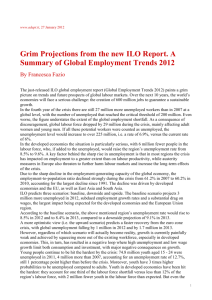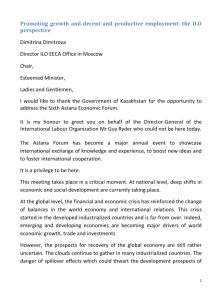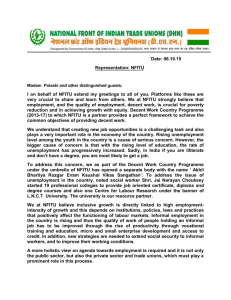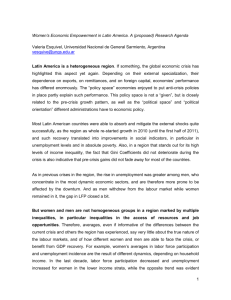Youth labour markets in developing economies
advertisement
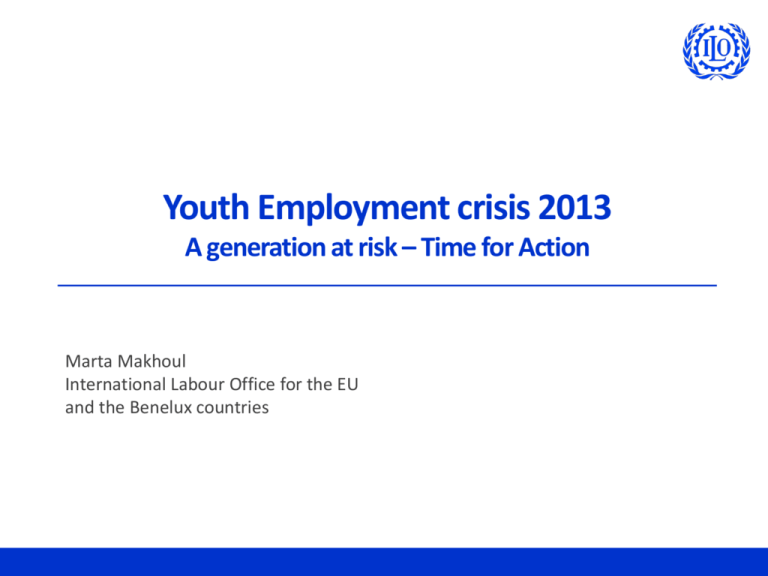
Youth Employment crisis 2013 A generation at risk – Time for Action Marta Makhoul International Labour Office for the EU and the Benelux countries A lost generation? 2 An unprecedented youth employment crisis… In 2012… 75 million young people are unemployed worldwide Globally young people are on average nearly three times more likely than adults to be unemployed Four out of every ten unemployed worldwide is a young women or man Over 1.2 billion people in the world between 15 and 24 years of age 40 % of the world's unemployed are young people…. BUT… But… Facts on youth employment crisis 3 ….Unemployment is only the tip of the iceberg Inequalities, insecurity and vulnerability are rising Quality of jobs available for youth is declining Underemployment and poverty for youth is on the rise Young workers are disproportionately represented in low-paid work Most young workers in developing countries are in the informal economy. Temporary employment and lack of permanent employment for youth is rising More insecure and slower transition from school to work Risk of SOCIAL UNREST Youth are increasingly discouraged than other age groups. Facts on youth employment crisis 4 Global youth unemployment and unemployment rate, 1991-2013 Source: ILO, Trends Econometric Models, February 2013. Global and regional youth unemployment 5 Global youth and adult unemployment from 1991-2013 Global youth and adult unemployment rate 6 European Union Youth unemployment rates (%), from 2000 2013 Youth unemployment rates in the EU 7 NEET rates in the EU Young people not in employment and not in any education or training 8 Consequences of youth unemployment Is likely to become more serious the longer youth unemployment crisis continues Raise risk of future unemployment and/or protracted period of unstable employment Valuable work experience is not acquired and professional skills may erode Effects more severe for youth entering the workforce with education level below tertiary level Is likely to result in wage scars that continue to depress employment and earnings prospects Consequences of youth unemployment Consequences of youth unemployment Youth are increasingly employed in non-standard jobs, including temporary employment and parttime work 9 Youth labour markets in developing economies Developing regions face major youth employment challenges and large variations in extent and development of youth unemployment Young workers often receive below average wages and are engaged in work for which either overqualified or underqualified Large numbers of young people not achieving full economic potential Unemployed In irregular employment (informal sector) Neither in labour force nor in education/training quality of work In countries with high poverty levels and high shares of vulnerable employment, youth employment challenge is as much a problem of poor employment quality as one of unemployment Youth labour markets in developing economies 10 Youth labour markets in developing economies • Labour markets in developing economies do not look like those in developed economies • Abundance of labour • Scarcity of capital • Duality between dominant traditional economies and “modern” economies • Irregular nature of employment • Leave education early • Lack of social protection • Different type of measurement needed Youth labour markets in developing economies 11 ILO’s response to the youth employment crisis: The 2012 ILC Resolution “The Youth Employment Crisis: A call for action” and its follow-up plan The Call for action focuses on five policy areas: 1. 2. 3. 4. 5. employment and economic policies to increase aggregate demand and improve access to finance; education and training to ease the school-to-work transition; labour market policies to target employment of disadvantaged youth; entrepreneurship and self-employment to assist potential young entrepreneurs; and labour rights that are based on international labour standards to ensure that young people receive equal treatment. ILO’s response to the youth employment crisis: 2012 ILC Resolution 12 The ILO youth employment programme Knowledge building Advocacy and promotion of decent work for youth Technical assistance ILO youth employment programme 13 ILO Active Labour Market Policies: What works for youth? • Policy measures should be balanced and adapted to country-specific needs Balanced strategies for growth and job creation Comprehensive packages of labour market measures targeting specific groups of young people Apprenticeships, skills training and other work-training programmes Platforms for exchanging knowledge and lessons of what works Targeted youth employment action through tripartite consensus and time-bound action plans Employment services Policies for youth employment Policiy measures Multiple services for entrepreneurship, social enterprises and cooperatives development Bipartite and tripartite cooperation 14 Best-practice example: youth guarantee in Sweden Sweden tackles youth unemployment through jobs guarantees It's not easy being a young jobseeker today. With nearly 74 million young people worldwide unemployed, youth guarantees programmes help keep youth connected to the labour market by boosting skills and giving them support to find jobs. http://www.ilo.org/global/about-the-ilo/multimedia/video/video-newsreleases/WCMS_212957/lang--en/index.htm Best-practice example 15 Thank you for your attention More info: http://ilo.org/global/research/global-reports/global-employment-trends/youth/2013/lang-en/index.htm http://www.ilo.org/global/topics/youth-employment/lang--en/index.htm http://www.ilo.org/ilc/ILCSessions/101stSession/texts-adopted/WCMS_185950/lang--en /index.htm
